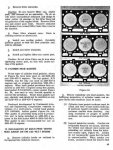Actually the broken rod bolt in the picture, had a crack all the way around right where the threads start, I know this because the area that was cracked prior to the engine letting go was coated with oil, the center of the bolt that finally broke all the way through was oil free, the threaded portion in the connectiong rod exited the motor and ended up on the side of the road.
I'll take more pics of the bolts today. I want to pull the intact rod bolt and send it along with the one that broke to be hardness tested somewhere.
I'd say that you found the smoking gun!
Stress breaks almost always start on the thread roots, as that forms a stress riser. That is why the old lathe cut "V" bolt standard was abandoned in favor of the UNS thread pattern. In addition to being easier to machine, the UNS pattern has a curved root that eliminates the stress riser at the thread root.
Here's an experiment you might want to try on one of the rods you haven't broken down yet:
Using a 6 point socket, take a sharpie marker, and draw line on the socket that goes down to the rod. .. (Or, you could take a long enough piece of tape and make a tape flag on the socket...) This is to give you an exact reference to the final angle to which the the nut was tightened. Set your torque wrench to the highest torque spec, from the TM, for the rod bolt. Loosen the rod nut 1/2T, and then torque it until the sharpie lines line up. If the wrench doesn't click before you reach the original angle, the nut was over torqued.
Thanks for all of your investigative work.
-Chuck





